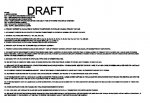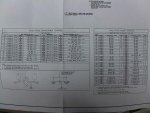Only thing I see that you may want to include is the SSBJ changing to EGC after the secondary OCPD.
The text in the second image is fairly small, distorted, and for the most part unreadable on my end...
here is the text.
NOTES:
1. ABBREVIATIONS
EGC - EQUIPMENT GROUNDING CONDUCTOR
GEC - GROUNDING ELECTRODE CONDUCTOR
GES - GROUNDING ELECTRODE SYSTEM
OCPD - OVER CURRENT PROTECTION DEVICE (TIME DELAY FUSE OR INVERSE TIME CIRCUIT BREAKER)
SBJ - SYSTEM BONDING JUMPER
SDS - SEPARATELY DERIVED SYSTEM
SSBJ - SUPPLY SIDE BONDING JUMPER
2. PRIMARY CURRENT IS CALCULATED BY DIVIDING TRANSFORMER VA RATING BY NOMINAL PRIMARY VOLTAGE.
3. SECONDARY CURRENT IS CALCULATED BY DIVIDING TRANSFORMER VA RATING BY NOMINAL SECONDARY VOLTAGE.
4. NOMIINAL VOLTAGES ARE TYPICALLY 480, 240, AND 120.
5. STANDARD RATINGS IN AMPERES FOR OCPD ARE 15, 20, 25, 30, 35, 40, 45, 50, 60, 70, 80, 90, 100, 110, 125, 150, 175, AND 200.
ADDITIONAL STANDARD AMPERE RATINGS FOR FUSES SHALL BE 1, 3, 6, AND 10.
IF EITHER OCPD RATING EXCEEDS 200A, ENGINEERING REVIEW IS REQUIRED.
6. PRIMARY OCPD RATING NOT TO EXCEED 250% OF PRIMARY CURRENT.
7. PRIMARY CONDUCTORS? MINIMUM CONDUCTOR AMPACITY 125% OF PRIMARY CURRENT.?AMPACITY MUST ALSO EQUAL OR EXCEED?PRIMARY OCPD RATING.
8. EGC MUST ROUTE WITH PRIMARY CONDUCTORS INSIDE SAME CABLE, RACEWAY, OR ENCLOSURE. SIZE PER T250.122 USING RATING OF PRIMARY OCPD IF A WIRE. EGC CAN BE BARE OR GREEN INSULATED WIRE, A METALLIC RACEWAY LISTED FOR USE AS AN EGC, THE METALLIC ENCLOSURE (OR A PROPERLY BONDED PANEL IN THE ENCLOSURE) THE CIRCUIT CONDUCTORS ARE ENCLOSED WITHIN, OR SOME COMBINATION THEREOF.
9. SBJ SIZED PER T250.66. MUST BE AN UNSPLICED WIRE, BARE OR GREEN INSULATED.
10. GEC MOST BE AN UNSPLICED WIRE, BARE OR GREEN INSULATED, SIZED PER T250.66. CONNECTS TO GES, GEC TERMINAL OR GEC BUS BAR.
11. SSBJ MUST ROUTE WITH SECONDARY CONDUCTORS INSIDE SAME CABLE, RACEWAY, OR ENCLOSURE. SIZE PER T250.66 IF A WIRE. IT MAY BE A BARE OR GREEN UNSULATED WIRE OR A METALLIC RACEWAY LISTED FOR USE AS AN EGC.
12. SECONDARY CONDUCTORS ?MINIMUM AMPACITY 125% OF SECONDARY CURRENT?AMPACITY. MUST ALSO EQUAL OR EXCEED?SECONDARY OCPD RATING.
13. SECONDARY OCPD RATING NOT TO EXCEED 125% OF SECONDARY CURRENT. MAY ROUND UP TO NEXT STANDARD SIZE OCPD RATING.
14. IF THE SECONDARY OCPD IS A MAIN CB IN A LISTED LOADCENTER, THE SBJ CAN BE A GREEN SCREW SUPPLIED BY THE LOADCENTER MANUFACTIRER RUN THROUGH THE NEUTRAL BAR INTO THE CASE OF THE LOAD CENTER. THE SBJ IS ONLY ALLOWED IN ONE OF THESE LOCATIONS.
15. IF THE SECONDARY OCPD IS A MAIN CB IN A LISTED LOADCENTER, THE GEC CAN BE CONNECTED TO THE LOADCENTER NEUTRAL BAR.THE GEC CAN ONLY BE CONNECTED IN ONE OF THESE TWO PLACES.
16. OTHER CONFIGURATIONS ARE POSSIBLE BUT WILL REQUIRE ENGINEERING REVIEW.
17. SBJ, SSBJ, EGC, AND GEC MAY BE BLACK INSULATED MARKED WITH GREEN TAPE AT ALL TERMINATIONS FOR WIRES LARGER THAN #6.
18. GEC MUST BE PROTECTED FROM PHYSICAL DAMAGE BY BEING ENCLOSED WITHIN A LISTED RACEWAY OR ENCLOSURE FOR SIZES SMALLER THAN #4. IF ENCLOSED WITHIN A METALLIC RACEWAY, IT MIST BE BONDED TO THE RACEWAY AT THE POINT IT ENTERS THE RACEWAY AND AT THE POINT IT LEAVES THE RACEWAY.




